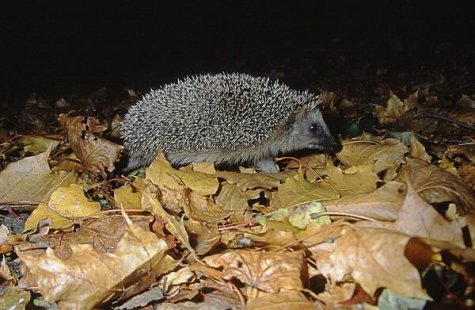Active period of hedgehogs’ year cycle is ending
Photo: Arne Ader
Translation: Liis
Hedgehog under maple
Common hedgehog; European hedgehog Harilik siil Erinaceus europaeus
The exceptionally warm and beautiful autumn is ending and so is the active part of the hedgehog’s year cycle. The magic 5-degree night and day average has not yet arrived - grass grows and hedgehogs can fatten up, and that is good. There are earthworms, snails, bugs and beetles and their grubs to be found among the leaves. On Sunday night hedgehogs at Nõmme were quite calmly busy.
Hedgehogs have become companions to humans, synanthropes; fewer enemies and maybe a richer dining table but they have become fewer too. Houses and gardens are more orderly, net fences reach to the ground and the number of dogs has increased. With cats we can even see hedgehogs eating together, particularly in fishing areas. While in summer hedgehogs moved only when dusk had arrived then in autumn we can meet them in daylight too.
Supposing that a hedgehog’s circuit is around two to three kilometres, there are a couple of resting places for the animals in some denser thickets close to the paths and of course a spot chosen for the winter hibernation: woodsheds and spaces below stairs are quite suitable, only leaves and moss need to be brought there for the winter bed. Brushwood stacks might do, but with winter thaws the bed can get wet and the hedgehog will perish.
The duration of hibernation will be roughly half a year and the body weight will decrease by a third during that time. Late-born young hedgehogs that have seen daylight in August should enter hibernation with a body mass of about 700 to 800 grams. With less they will not survive winter, but with a warm autumn it is possible to achieve the weight.
A hedgehog has a limited amount of stored energy matter in its body. Warmth is produced from the so-called „brown fat“ layer. Depending on the weather, the body temperature of a hibernating hedgehog can drop to +4 degrees or 35 degrees less than in summer. Heartbeats in winter are about 20 per minute and in summer about 190. In winter only 1/100 of the daily energy use per day in summer (about 70 grams of food is consumed) is used, an amazing energy economy.
The hedgehog’s body needs water in winter, and that too is obtained from fat. The intestines must work in winter in order to remove nitrogen from the organism, or in other words, excrements are dropped in the winter nest.
Researchers confirm that a hedgehog wakes up at intervals of about once a week, to warm its organism corresponding to changes in weather. While hibernating it is unable to act, and does not react even on disturbances.
Wishing all “pincushions“ a dry and warm winter nest!









